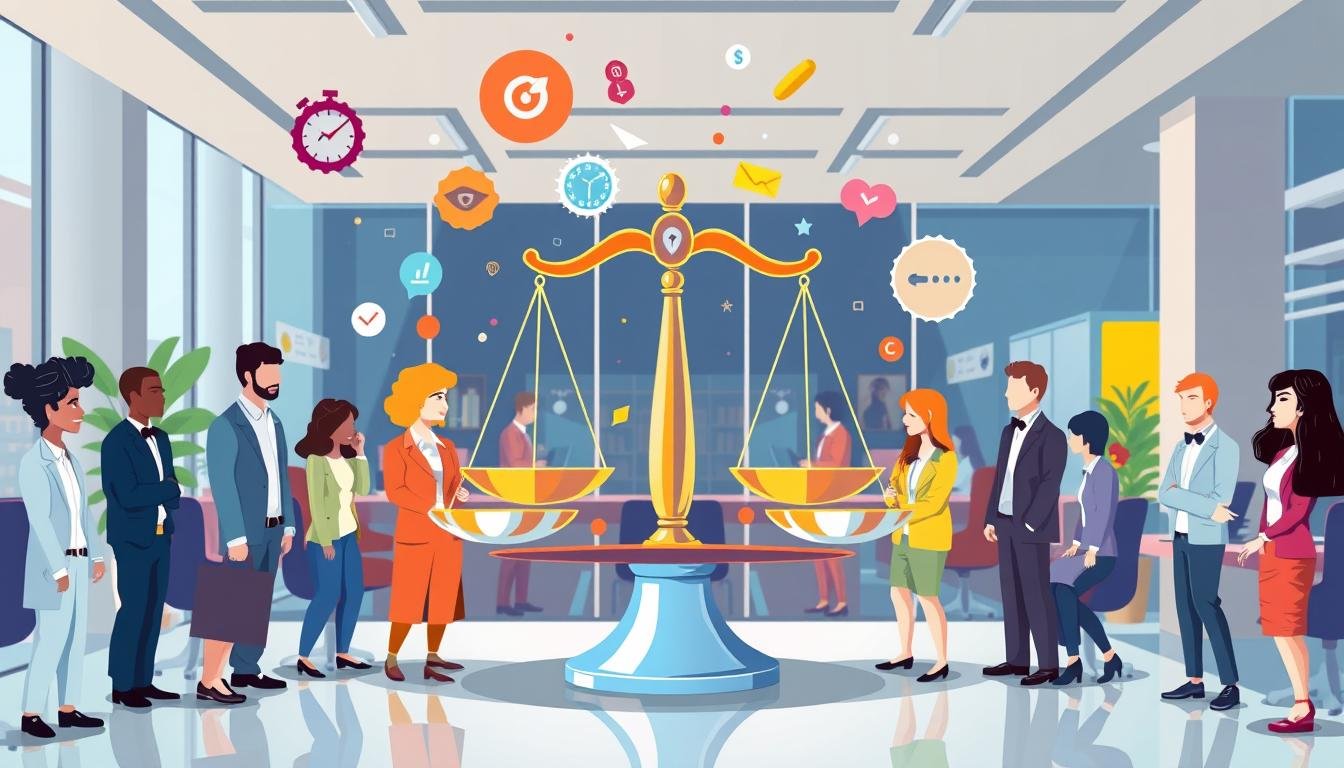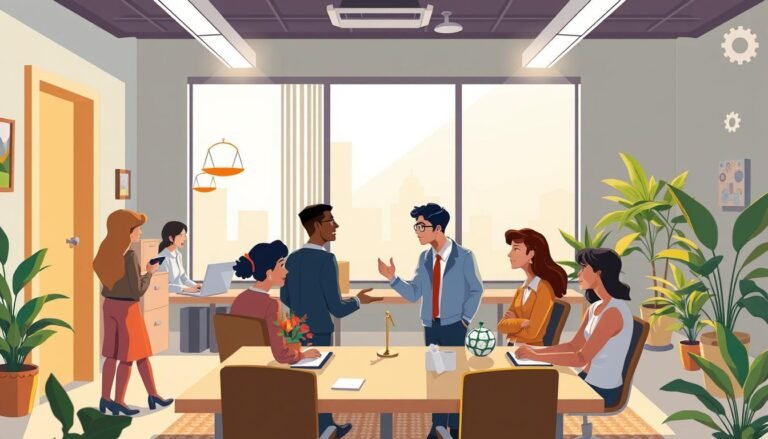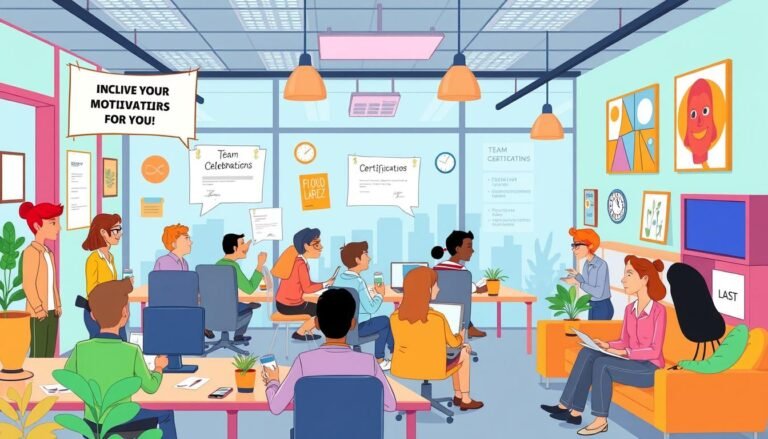Organizational Justice: How Fairness Drives Employee Satisfaction
Is your workplace truly fair? This question is at the core of organizational justice. It’s changing how companies view employee happiness. In today’s job market, fairness is not just good—it’s essential.
Organizational justice is about how employees see fairness at work. It includes how resources are given out and how decisions are made. It also involves how people interact. As more businesses see its effect on work performance, it’s becoming a big topic.
Recent studies show the power of fairness at work. A survey of 329 employees found that seeing fairness boosts engagement. It also lowers burnout, turnover, and being present but unhappy at work. These results show how important fairness is for keeping employees happy and on board.
The idea of organizational justice isn’t new, but it’s more important now. Since the 1960s, researchers have looked into how fairness affects work. In the 1980s, Jerald Greenberg introduced the term “organizational justice,” starting a new wave of study.
Today, wise leaders know that fairness is key. They use clear communication and fair treatment to help employees do their best. They also keep the best workers. As we explore this topic further, we’ll see how to create a fair work culture that makes employees happy and helps your business grow.
Key Takeaways
- Organizational justice greatly affects employee engagement and happiness
- Fairness perceptions impact burnout, turnover, and work quality
- Clear communication and fair treatment are vital for justice
- Creating fairness helps attract and keep the best workers
- Understanding organizational justice is crucial for better work outcomes
Understanding Organizational Justice
Organizational justice is a big deal in today’s workplaces. It shapes how employees see their jobs and the company culture. It’s not just about fair pay. It’s about how decisions are made and how staff are treated.
Definition and Importance
Organizational justice means fairness at work. It affects how employees see their bosses and jobs. Fair treatment makes workers happy and keeps them around longer. But unfair practices can lead to low morale and high turnover.
Evolution of the Concept
The idea of fairness at work has grown. It started with just fair pay. Now, it includes how decisions are made and interactions. This shows a deeper understanding of what makes employees feel valued.
Impact on Employee Engagement
Fair treatment boosts employee engagement. When staff feel respected, they work better. Studies show that fairness affects job satisfaction and commitment. Equity theory explains why fairness is so important to workers.
| Justice Perception | Employee Outcome | Impact Level |
|---|---|---|
| High Fairness | Job Satisfaction | Moderate Increase |
| Low Fairness | Turnover Intention | Moderate Increase |
| Clear Communication | Retaliation Risk | 43% Decrease |
Understanding organizational justice helps make better workplaces. It leads to more engaged employees and stronger companies. As work cultures change, fairness remains key to success.
The Three Pillars of Organizational Justice
Organizational justice is key in shaping how employees feel and act. It has three main parts that help make a workplace fair.
Distributive Justice
Distributive justice is about fairness in how resources and rewards are given out. Employees see if they get fair pay for their work. This affects how happy and motivated they are at their jobs.
Procedural Justice
Procedural justice is about the fairness in how decisions are made. It’s about being open and consistent in how things are done. When people see this fairness, they are more likely to agree with decisions, even if they don’t get what they want.
Interactional Justice
Interactional justice is about how people are treated during work processes. It has two parts:
- Interpersonal justice: Being treated with respect and dignity
- Informational justice: Getting clear and timely information about decisions
Studies show these justice pillars greatly affect things like trust, commitment, and how much employees contribute. A study by Colquitt found that a four-factor model of justice (including informational justice) is good for many work outcomes.
| Justice Type | Focus | Impact |
|---|---|---|
| Distributive | Fairness of outcomes | Job satisfaction, motivation |
| Procedural | Fairness of processes | Decision acceptance, trust |
| Interactional | Quality of treatment | Employee engagement, loyalty |
By knowing and using these pillars, companies can make a fairer work place. This leads to happier employees and better work performance.
The Role of Leadership in Fostering Organizational Justice
Leaders are key in making workplaces fair. They create clear rules for sharing resources and making decisions. They also listen to employees, showing they value everyone’s opinion.
This builds trust and sets a fair culture. Ethical leaders are crucial in making workplaces just. They talk openly and follow rules, making employees feel respected.
- Higher levels of organizational justice lead to increased employee trust in leadership
- Companies prioritizing fairness see improved employee well-being
- Organizations with strong justice practices have higher employee retention rates
Transformational leaders inspire employees to work for the greater good. They foster shared values and a fair work environment. On the other hand, transactional leaders also play a role in fairness, linking leadership style to employee performance.
| Leadership Style | Impact on Organizational Justice | Employee Outcomes |
|---|---|---|
| Transformational | Promotes fairness and shared values | Increased motivation and job satisfaction |
| Transactional | Positively associated with justice | Improved performance through clear expectations |
By following these leadership principles, companies can make a fair work environment. This boosts employee happiness, trust, and performance.
Human Resources and Organizational Justice
HR practices are key in shaping how employees see their workplace. The Human Resources department works to make sure the company is fair and just. They do this by creating policies, starting new programs, and always looking to get better.
Developing Fair Policies and Procedures
HR teams make policies that support equality and fairness. They make sure everyone knows how they’re judged, making things more transparent. A study showed that when employees see their performance data, they feel things are fairer.
Implementing Justice-Related Initiatives
HR leaders start projects to make things more just. These might include:
- Checking if everyone is paid the same to fix any unfairness
- Programs for diversity, equity, and inclusion
- Clear ways to show how much people are paid to fight inequality
Monitoring and Improving Justice Standards
Keeping an eye on fairness is important. HR looks at important numbers to see if their efforts are working:
| Metric | Impact |
|---|---|
| Employee Satisfaction | Higher levels in organizations with fair processes |
| Turnover Rate | Lower in companies investing in fairness |
| Organizational Citizenship Behavior | Enhanced by perceived justice |
By focusing on fairness, HR can really change the company culture. This leads to better work, more engagement, and stronger loyalty from employees.
Strategies for Enhancing Fairness in Decision-Making
Workplace fairness is key to a successful company. To improve fairness, companies should focus on being open and inclusive. Ethical leadership is important in setting the right example for everyone.
One good way is to have clear rules for making decisions. This means listing what to consider and how important it is. This helps avoid unfairness and keeps things consistent.
It’s also smart to listen to many viewpoints. When workers get to help shape decisions, they feel more included. In fact, companies that listen to everyone do better financially and come up with more new ideas.
Keeping communication open is essential. Regular checks on how decisions are made and asking for feedback can make things clearer. Companies that listen to their employees do better in keeping their team happy and reducing stress.
- Implement digital dashboards for enhanced transparency
- Encourage collaboration platforms for diverse input
- Conduct regular reviews of decision-making processes
- Seek and act on employee feedback
How employees see fairness matters a lot. By listening to their ideas and showing they matter, leaders can make things better. This not only makes things fairer but also builds trust and happiness at work.
The Impact of Organizational Justice on Workplace Outcomes
Organizational justice is key in shaping workplace results. Studies show it greatly affects employee engagement, company culture, and trust in leaders.
Job Satisfaction and Employee Well-being
A study with 2,566 employees from 45 factories found a strong link between fairness and positive work behavior. This shows fairness is vital for job happiness and employee health.
Trust in Organization and Leadership
A study of 747 employees showed procedural justice is more important than distributive justice for positive behavior. This highlights the need for fair processes to build trust and a positive culture.
Employee Retention and Productivity
Research shows organizational justice greatly affects keeping employees and their performance. Fryxell and Gordon found that happy employees perform better.
| Justice Type | Impact on Behavior | Effect on Outcomes |
|---|---|---|
| Distributive Justice | Influences fairness perception of outcomes | Affects job satisfaction |
| Procedural Justice | Shapes perception of decision-making fairness | Enhances trust and commitment |
| Interactional Justice | Impacts interpersonal treatment perception | Improves employee engagement |
By focusing on fairness, companies can improve work environments. This leads to better employee engagement, a strong culture, and trust in leaders. It results in better workplace outcomes and success.
Organizational Justice in the Digital Age
The digital workplace has changed how we see fairness at work. With remote teams and online chats, keeping things fair is harder. Leaders face new challenges in making sure everyone feels treated right online.
A study in western China showed nurses’ mental health was linked to fairness at work. It found that fairness was a big factor in their mental health, making up 20.5% of their issues. This shows how important fairness is for everyone’s well-being, even when working online.
In the tech world, big layoffs by email have raised questions about digital ethics. These situations show we need to think carefully about how we communicate online. Companies must find a balance between being efficient and showing empathy in their digital actions.
Digital tools can make decisions clearer, which is key for fairness. But, they need to be used wisely to keep communication respectful. Leaders must figure out how to make fairness work in remote teams, across different digital spaces.
| Justice Aspect | Digital Workplace Challenge | Potential Solution |
|---|---|---|
| Distributive | Unequal access to resources | Provide tech stipends for remote workers |
| Procedural | Lack of transparency in decisions | Use collaborative decision-making platforms |
| Interactional | Impersonal digital communication | Regular video check-ins with team members |
As we move forward, leaders must focus on fairness in all online interactions. This way, companies can build a positive digital work culture. Such a culture supports both employee happiness and productivity.
Challenges in Implementing Organizational Justice
Today’s business world is diverse and dynamic. This makes it hard for companies to ensure fairness in the workplace. They face challenges in creating a fair environment, dealing with different employee views, and cultural differences.
Overcoming Biases and Perceptions
Dealing with biases is a big challenge. Studies show that some people think promotions of Black employees are unfair. This shows the need for strong diversity and inclusion efforts to make workplaces fair for everyone.
Balancing Individual and Organizational Needs
Finding a balance between what employees want and what the company needs is tough. Many changes fail because of how employees feel. It’s important to make sure personal needs match company goals to ensure fairness and readiness for change.
Addressing Cultural Differences
In our global world, understanding cultural differences in justice is key. Big companies often prefer employees from their home country. This can make others feel left out and unfair. Companies must focus on fairness and understand and respect different views to overcome these issues.
Source Links
- The Effects of Organizational Justice
- Organizational Justice and Employee Readiness for Change: The Mediating Role of Perceived Organizational Support
- Fairness – what is it, and how should it be measured?
- Organizational Justice | Quality Improvement Center for Workforce Development
- What is Organizational Justice and Why Should You Care Right Now?
- No title found
- Organizational justice
- The benefits of organizational justice and practical ways how to improve it | CQ Net – Management skills for everyone
- How Organizational Justice Impacts Workplace Outcomes | JWU CPS
- Role of Organizational Justice in Linking Leadership Styles and Academics’ Performance in Higher Education
- Organizational Justice 101: How to Foster Fairness in the Workplace | ChartHop
- Why Organizational Justice Can Have an Enormous Impact on the Workplace
- Three Ways Your Organization Can Build Fairness And Justice
- Organizational Justice – Meaning, Types and Applications
- Justice, Equity and Fairness. How Business can Improve Employee Morale. – ActionCOACH
- The Effects of Organizational Justice on Positive Organizational Behavior: Evidence from a Large-Sample Survey and a Situational Experiment
- The impact of organizational justice on psychological distress among Chinese public hospitals nurses: A cross-sectional study
- Organizational Justice and Health: A Survey in Hospital Workers
- Frontiers | Grand challenges in organizational justice, diversity and equity
- Frontiers | Organizational Justice and Employee Readiness for Change: The Mediating Role of Perceived Organizational Support







